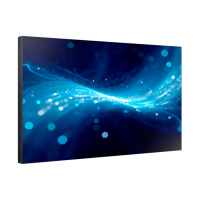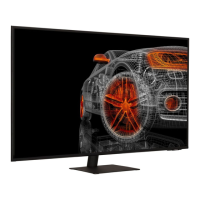Do you have a question about the Samsung S49CG95 E Series and is the answer not in the manual?
General safety warnings and guidelines for product usage.
Guidelines for safe electrical connection and usage to prevent hazards.
Instructions and warnings for correctly installing the product.
Guidelines and warnings for safe product operation.
Procedures for cleaning the product safely and effectively.
Guidance on maintaining proper posture for user comfort and health.
Steps and guidance for installing the monitor and its components.
Safety guidelines and warnings for safely moving the product.
Ensuring proper ventilation space and adjusting monitor tilt/height.
Details on VESA mount compatibility and installation requirements.
Explanation of the monitor's control panel buttons and functions.
Important information and checks before connecting the product and source device.
Overview of monitor ports and initial PC connection methods.
Details on connecting DP cable, audio devices, and using the monitor as a USB hub.
Instructions for connecting the power cord and tidying cables.
Guidance on setting the optimal screen resolution for best performance.
Configuration options for game-related display settings: refresh rate, response time, sync tech, aim point, lighting, and screen size.
Adjusting picture quality, brightness, contrast, color, white balance, gamma, and black level settings.
Settings for eye relaxation, adaptive picture, minimum brightness, and eye saver mode.
Adjusting screen position, viewing calibration reports, and resetting picture settings.
Configuring Picture-in-Picture and Picture-by-Picture modes, including screen size and source.
Configuring menu language and display time duration.
Adjusting system features like timers, input port version, source switching, key repeat, power LED, custom key, brightness, and VRR.
Accessing self-diagnosis, software updates, product registration, and reset options.
Guide to installing and using the Easy Setting Box software for screen partitioning.
Instructions for downloading and installing product drivers for optimal performance.
Hardware and OS requirements for installing the software.
Potential issues and limitations during software installation.
Steps to take before contacting customer service for assistance.
How to run self-diagnosis for screen-related problems.
Verifying and adjusting screen resolution and frequency settings.
Troubleshooting blank spaces or display problems when using PC mode.
Addresses various display problems like color inconsistency, blurriness, and flickering.
Troubleshooting no sound problems and boot-up beeping sounds.
Answers common questions about changing frequency, resolution, and power-saving modes.
Details on model name, size, display area, pixel pitch, power, signal connectors, and environmental conditions.
Information on Plug-and-Play, panel dots, audio, and open source licenses.
Technical table listing resolutions, frequencies, and port compatibility.
Explains conditions under which service fees may be charged to the customer.
Explains FreeSync technology, its settings, and compatible AMD graphics cards.
General safety warnings and guidelines for product usage.
Guidelines for safe electrical connection and usage to prevent hazards.
Instructions and warnings for correctly installing the product.
Guidelines and warnings for safe product operation.
Procedures for cleaning the product safely and effectively.
Guidance on maintaining proper posture for user comfort and health.
Steps and guidance for installing the monitor and its components.
Safety guidelines and warnings for safely moving the product.
Ensuring proper ventilation space and adjusting monitor tilt/height.
Details on VESA mount compatibility and installation requirements.
Explanation of the monitor's control panel buttons and functions.
Important information and checks before connecting the product and source device.
Overview of monitor ports and initial PC connection methods.
Details on connecting DP cable, audio devices, and using the monitor as a USB hub.
Instructions for connecting the power cord and tidying cables.
Guidance on setting the optimal screen resolution for best performance.
Configuration options for game-related display settings: refresh rate, response time, sync tech, aim point, lighting, and screen size.
Adjusting picture quality, brightness, contrast, color, white balance, gamma, and black level settings.
Settings for eye relaxation, adaptive picture, minimum brightness, and eye saver mode.
Adjusting screen position, viewing calibration reports, and resetting picture settings.
Configuring Picture-in-Picture and Picture-by-Picture modes, including screen size and source.
Configuring menu language and display time duration.
Adjusting system features like timers, input port version, source switching, key repeat, power LED, custom key, brightness, and VRR.
Accessing self-diagnosis, software updates, product registration, and reset options.
Guide to installing and using the Easy Setting Box software for screen partitioning.
Instructions for downloading and installing product drivers for optimal performance.
Hardware and OS requirements for installing the software.
Potential issues and limitations during software installation.
Steps to take before contacting customer service for assistance.
How to run self-diagnosis for screen-related problems.
Verifying and adjusting screen resolution and frequency settings.
Troubleshooting blank spaces or display problems when using PC mode.
Addresses various display problems like color inconsistency, blurriness, and flickering.
Troubleshooting no sound problems and boot-up beeping sounds.
Answers common questions about changing frequency, resolution, and power-saving modes.
Details on model name, size, display area, pixel pitch, power, signal connectors, and environmental conditions.
Information on Plug-and-Play, panel dots, audio, and open source licenses.
Technical table listing resolutions, frequencies, and port compatibility.
Explains conditions under which service fees may be charged to the customer.
Explains FreeSync technology, its settings, and compatible AMD graphics cards.












